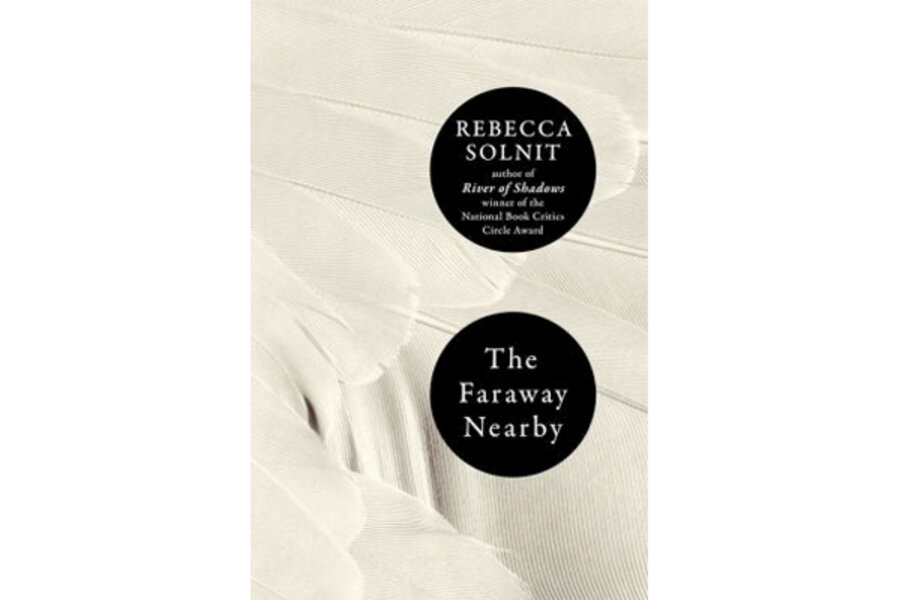The Faraway Nearby
Loading...
“We are ourselves stories, telling and being told.” This is the central claim of Rebecca Solnit’s mesmerizing new book, The Faraway Nearby.
In Solnit’s view, we build our world and ourselves out of stories: we are always listening to them or telling them, adapting them or creating them, sharing them or hoarding them. “Where does a story begin?” Solnit asks. “The fiction is that they do, and end, rather than that the stuff of a story is just a cup of water scooped from the sea and poured back into it.” For Solnit, the world is stories all the way down.
"The Faraway Nearby" is, at its core, an examination of the storytelling impulse, though “examination” is far too stuffy a word to describe this delightful book. Solnit wears many different professional hats – she’s an award-winning historian as well as an activist, critic, and public intellectual – and "The Faraway Nearby" is itself a strange mixture of genres.
At times, the book reads like a work of literary criticism, as when Solnit offers interpretations of Mary Shelley’s "Frankenstein" and Hans Christian Anderson’s “The Snow Queen.” At other times, it reads like cultural anthropology, following folk tales as they are passed on from generation to generation, culture to culture, shifting and sliding in the process: “Stories migrate; meanings migrate; everything metamorphoses.”
At still other times, it reads like a memoir. Running like a thread through the book’s labyrinthine structure is Solnit’s account of her mother’s struggles with Alzheimer’s, a disease that is so terrifying precisely because it breaks down a person’s sense of self, the story that person tells about how he or she got from the past to the present. Solnit imagines her ailing mother as a “book coming apart, pages drifting away, phrases blurring, letters falling off” – she is, in short, a story that is being untold.
"The Faraway Nearby" isn’t so much a single, coherent argument about the nature of stories, as it is a series of meditations upon the subject. Solnit understands “story” in the most encompassing sense. Illness, she argues, is a kind of story – here is how I moved from health to sickness. So are legal cases, with the defendant and the prosecutor each trying to convince the jury of a particular narrative; so is history; so is the life of a nation; so is the life of an individual; the list goes on.
The sheer quantity of stories that Solnit gathers together in one place is staggering. She offers her thoughts on "The Chronicles of Narnia" and on "The Buddhacarita," on the Inuit story of the “Skeleton Woman” and on the German fairy tale “The Juniper Tree.” "The Faraway Nearby," in other words, doesn’t tell a story about stories. It tells stories about stories, drifting from one narrative to the next, using each story as a springboard for broader considerations. This rhizomatic structure is simultaneously bewildering – you find yourself wondering how you got from Che Guevara to the Roadrunner in a matter of pages – and exhilarating.
Despite its digressive style, "The Faraway Nearby" does put forward several concrete claims about the nature and purpose of storytelling. Solnit argues that stories, both in the telling and in the listening, allow for an expansion of the self that can lead to empathy. The word empathy, Solnit tells us, comes from the German Einfuhlung, which means “feeling into,” and it is by listening to another’s story, by imagining their story as our story, that we come to recognize and care about existences other than our own. (Solnit regularly uses etymology to clarify her own language. Even individual words, it appears, have stories to tell.)
If stories can lead to empathy, then they also can lead to a rigidity of mind and spirit: once you’ve told yourself a story about something – another person, another race, another world – it’s hard to un-tell it. Solnit describes the “temptation of a neat ending, that point when you bring the boat to shore and tie it to the dock and give up the wide sea.”
Solnit’s own book refuses this temptation. Ends are never tied up but always lead to new beginnings; one story simply gives way to another and another and another. As Solnit writes, “The quest is the holy grail, the ocean itself is the mysterious elixir, and if you’re lucky you realize it before you dock at the cup in the chapel.”
Anthony Domestico’s reviews have appeared in the TLS, the Boston Globe, and the San Francisco Chronicle. He is the book columnist for Commonweal.






